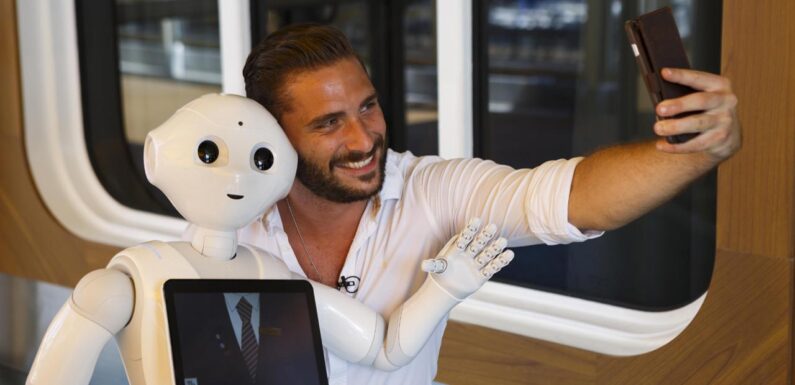
Mobile robotics is the use of robots that can move around and operate in a lot of different places. Sensors and algorithms let these robots navigate and do things on their own without being controlled by humans. Manufacturing, transportation, healthcare, and even military and defence are all places where you’ll find these robots. The field of mobile robotics is rapidly growing, revolutionizing the way we think about automation and efficiency, and it could have a positive and negative impact on society. With mobile robotics, the possibilities are endless, from driverless cars to delivery drones, and they’re constantly evolving.
Why is Mobile Robotics Important?
There are a lot of reasons why mobile robotics is so valuable. First of all, it allows humans to do things that are dangerous or impractical for them. Mobile robots can be used in disasters to look for survivors or assess the damage or operate in dangerous environments like nuclear power plants or chemical factories. In addition to assembly lines and warehouses, mobile robots are great for tasks that require precision or repeatability.
Moreover, mobile robots can work 24/7 without stopping for breaks or rest, so they’re more efficient and productive. Moreover, mobile robots are used to perform tasks that are physically demanding or require a lot of endurance, like mowing lawns or inspecting pipelines and power lines.
Additionally, mobile robotics has the potential to revolutionize several industries by making everyday tasks easier & more convenient and increasing efficiency & productivity.
How These Intelligent Machines Are Revolutionizing Industries and Our Lives?
Mobile robots are used in a variety of industries and applications. Some of its uses across industries include:
- Manufacturing: Mobile robots are used in manufacturing for transporting materials, assisting with assembly, performing quality inspections, and handling hazardous materials.
- Warehousing and logistics: A lot of warehouses and distribution centres use mobile robots to move and locate items, load and unload trucks, and move cargo.
- Military and security: Mobile robots are great for surveillance, bomb disposal, transporting equipment, and other military & security tasks.
- Agriculture: Mobile robots are used in agriculture to do stuff like crop monitoring, planting, watering, and harvesting.
- Healthcare: Robots can transport medications, medical supplies, and equipment within hospitals, as well as deliver medications.
- Retail: Mobile robots are used in retail for inventory management and managing customer service.
- Service industry: Mobile robots are used in the service industry to deliver food & beverages and provide customer assistance.
- Education and research: In educational and research settings, mobile robots help students learn about robotics and do experiments.
Adopting Mobile Robotics
Adopting mobile robotics involves integrating and using mobile robots. In addition to purchasing and implementing mobile robots into workflow and operations, employees must also be trained on how to use and maintain them. It is also necessary to determine how robots can be integrated into existing processes and systems as well as to assess their potential advantages and disadvantages when adopting mobile robotics.
It can have several benefits, including increased efficiency, reduced labour costs, and improved safety. The adoption of mobile robotics may also pose ethical and legal challenges, such as how it could affect job security and employment. A smooth and successful integration of mobile robotics requires careful planning and consideration.
New Technologies and Innovation Will Continue to Drive the Mobile Robotics Industry
Technology and innovation are driving the evolution and advancement of the mobile robotics industry. Among the key areas of innovation in mobile robotics is the development of advanced artificial intelligence and machine learning technologies, which allow robots to perform tasks in an autonomous and adaptable manner, reducing the need for human intervention.
It also involves the development of sophisticated sensors and navigation systems to assist robots in navigating and interfacing with their surroundings more effectively, along with machine learning to allow robots to learn and improve over time. In addition, the increasing use of 5G technology will drive the growth of the mobile robotics industry as it enables faster and more reliable communication between robots and their controllers.
Moreover, advances in wireless and connectivity technologies are enabling mobile robots to communicate and interact in real time with each other and with other devices, further increasing their capabilities and functionality. Overall, mobile robotics is expected to continue to be driven by new technologies and innovations, leading to substantial advances and improvements.
The future of mobile robotics
A lot of speculation and excitement surrounds the future of mobile robots as technology and artificial intelligence continue to push the boundaries of what is possible. A wide variety of tasks and functions can be performed by mobile robots with a high degree of autonomy as they become increasingly intelligent and capable. The use of mobile robots in homes, offices, factories, and hospitals will become increasingly common.
Cleaning, security, transportation, and delivery are some of the tasks it can perform, along with providing elderly care. As mobile robots become increasingly intelligent and adaptable, they will be able to learn and adapt to their environments and perform a wider range of tasks, thereby becoming more useful. As a result of the development of mobile robots, humans and robots will be able to collaborate in the future, resulting in mobile cobots which work in tandem to accomplish shared goals.
Mobile robots could also be used for space exploration, paving the way for humans to colonize other planets in the future. In general, mobile robots are expected to revolutionize the way we live and work in the future, bringing significant advances and improvements to a wide range of fields.

